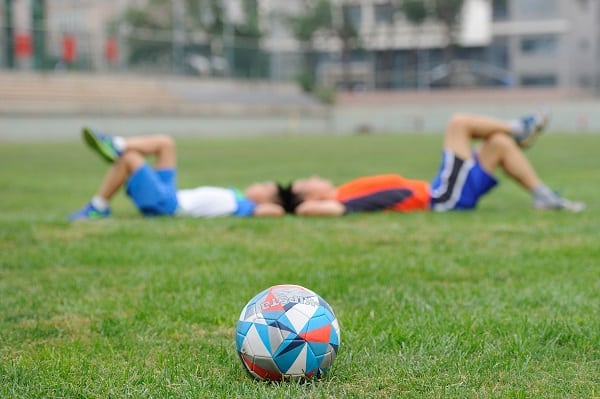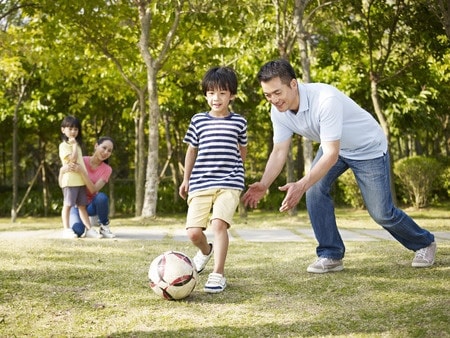Get Out And Play! Why Your Child Should Make Time For Sports
Submitted by KiasuEditor
What’s one difference between children from local schools and children from the international schools? A true love for sports, it seems.

Singaporean students (or their parents) are more likely to request medical certificates to be excused from sports, whereas international school students are more likely to seek medical advice for a faster healing of injuries, so that they can resume sports participation.
This observation was made by sports physician Benedict Tan back in 2015, during his stint as a nominated member of parliament.
Are Local Students Getting Enough Exercise?
A 2014 study also found that Singaporean teens were not active enough—none of the 244 secondary school students involved in the study met the national guideline of having at least an hour of moderate physical activity a day. (An example of a moderate activity would be a brisk walk.)
Today’s students are likely to relate to a weekly routine such as this:
“I don’t mind sports like netball, but I just don’t have the time. My typical school day consists of lessons, CCA—the IT club in my case—then tuition and homework. On weekends, I play computer games and watch my favourite TV shows and movies on my laptop.”
“If this behaviour becomes entrenched, it may have dire consequences on the future physical and metabolic health of adult Singaporeans,” says physical education expert Michael Chia, who authored the 2014 study mentioned above.
Already, obesity rates among local children have risen slightly in recent years. There is also concern that local youths (even those without weight issues) who remain sedentary into adulthood will have a higher risk of heart disease, stroke, and diabetes.
The Benefits Of Sports
Plans are underway to incorporate a daily hour of physical activity into the local preschool curriculum. But for those in primary and secondary school, parents may have to intervene.
There is good reason to do so, as the benefits of sports extend beyond physical health, says youth football coach Jahsh Ruzzman.
“I know kids who have grown up in sports, as well as others who haven’t, and the difference is often drastic. I firmly believe that sports can help kids develop confidence, perseverance, and resilience. Kids can learn life skills from sports that they will carry with them in whatever they choose to pursue.”
Schoolbag.sg has interviewed several local students on what they’ve gained from being actively involved in sports. (Watch the videos here.)

For primary schooler D. Geerish Dass Naidu, who plays volleyball, it’s the ability to think on one’s feet, as well as learning to work as a team. Secondary school rugby player Givens Teo says the sport gives him the opportunity to play alongside those from different backgrounds. Junior college student Zac Liew enjoys the adrenaline rush of gymnastics. Lim Bing, also in junior college, says she experiences “genuine joy” with table tennis in her life.
Above all, sports also provides lessons in resilience—an essential trait that kids need to thrive in life.
“Winning is not very important, as it’s… the experience that counts,” says primary schooler Low Xin Yi, who plays badminton. “When you lose, you will actually gain a new experience. You can look at how other people play… and learn from them, so that you give a better performance in the next round.”
Helping Kids To Embrace Sports
How can parents encourage their children to play sports more regularly? As a first step, you could explore the co-curricular activities in your child’s school.

“What sports CCAs do is that they equip the child with… the necessary skills [for the sport],” says Joel Vinson, who oversees co-curricular activities at First Toa Payoh Primary School. “I want them to be able to enjoy the sport. That’s most important—they have to have fun.”
Parents may also wonder: how should one narrow down a school’s CCA options to a single choice?
“Primary schools now offer CCAs such as sailing, bowling, and cricket,” says football coach Jahsh. “So, how should one choose? I let my kids choose their interests, and try as best as I can to support, encourage, and motivate them along the way. I believe the child ought to decide.”
If your child expresses interest, you could also sign him or her up for trial sports classes at nearby enrichment schools and community centres. However, don’t fret if your family is grappling with time or budget constraints.
“The initial goal of making sports a part of your child’s life should not be to raise an Olympian or elite-level athlete, but to reap the physical, mental, and emotional benefits of sports through active participation at any level,” says Jahsh. “Just get out there and do something fun. Go for walks around the neighbourhood. Play in the rain. Jump in puddles.”
Even when you’re playing a casual game such as Frisbee, there are opportunities for learning.
“[If] your kids are frustrated that their Frisbee isn’t travelling far enough, show them how you do it, and ask them to give your method a try,” suggests Jahsh. “When kids are trying out a new technique, always ask them if the change has helped bring about improvement, and get them to verbalise what they feel has improved.”
Parents Can Make A Difference
If your children are reluctant to participate in outdoor activities, you may have to take the lead, in order to show them the joys of being active.
You could designate a Saturday as your family’s “cycling day,” or implement a daily family walk after dinner, suggests KSP member bud hubs. On rainy days, challenge your kids to a stair-climbing race. (Read more of his family exercise tips here.)
“Parents need to exercise not only for themselves, but also for their children’s benefit,” he says. “It is important for us to set a good example to our children, and let them know that we engage in exercise to stay healthy.”